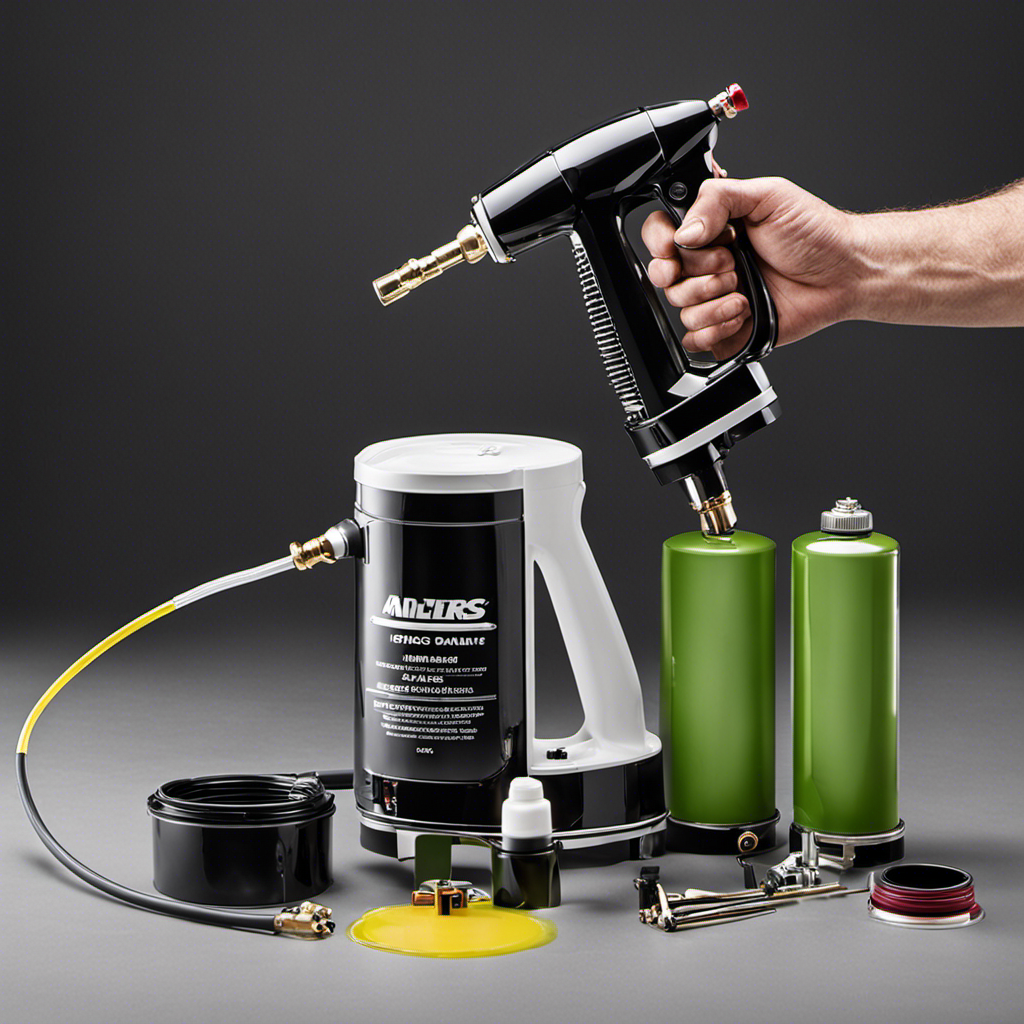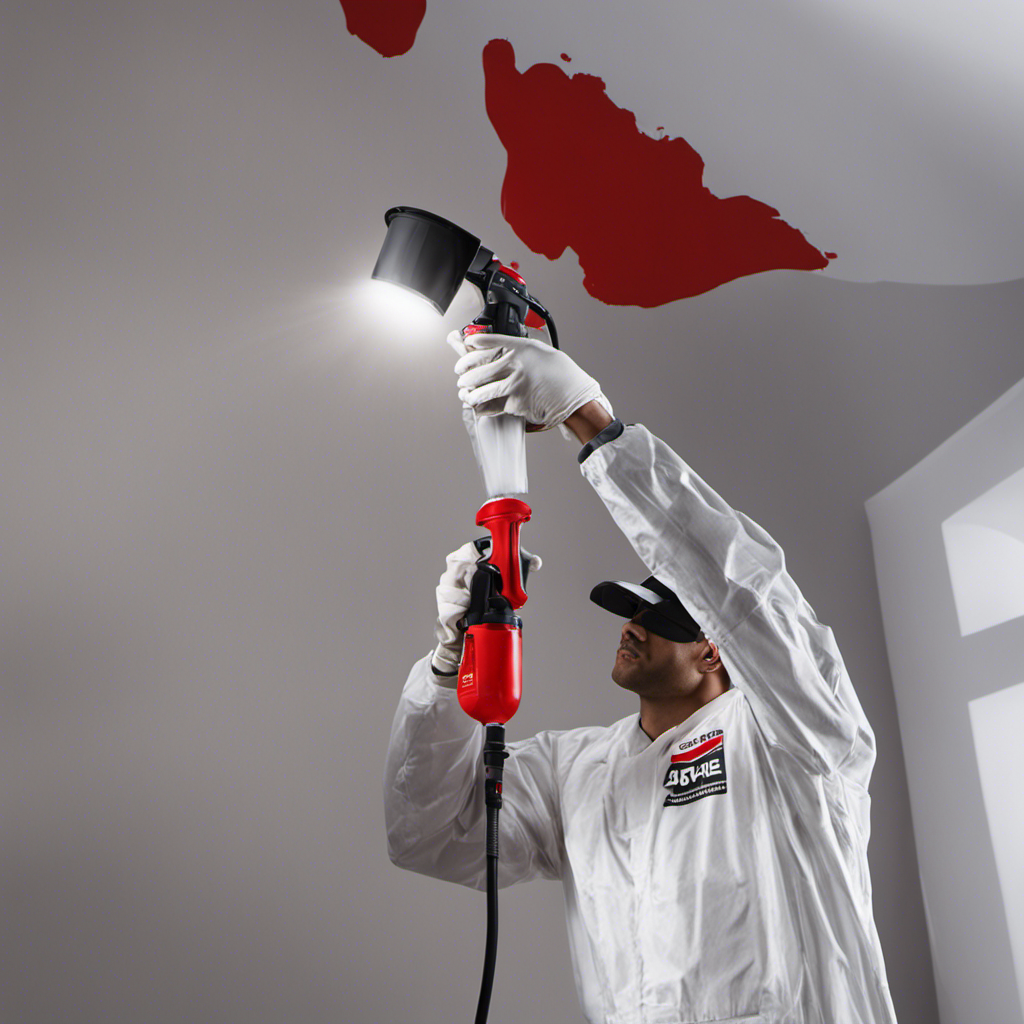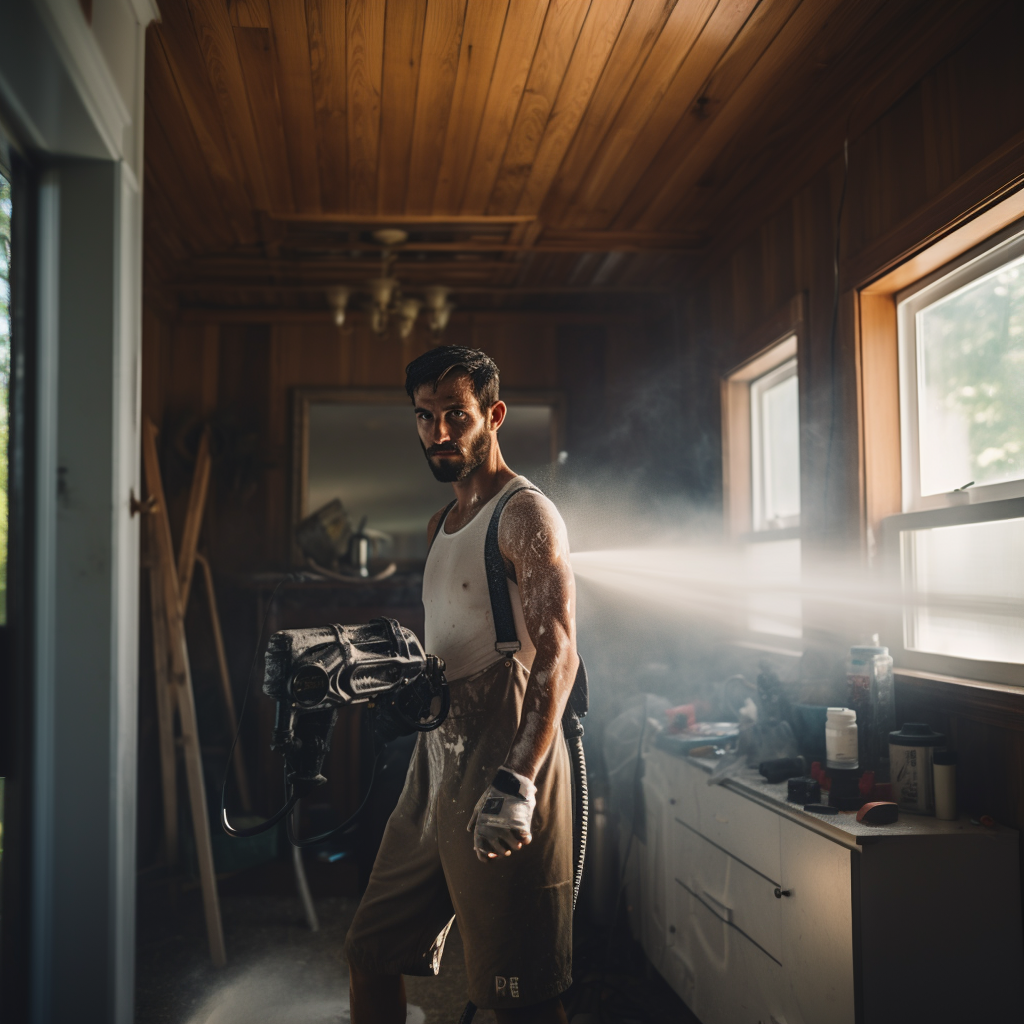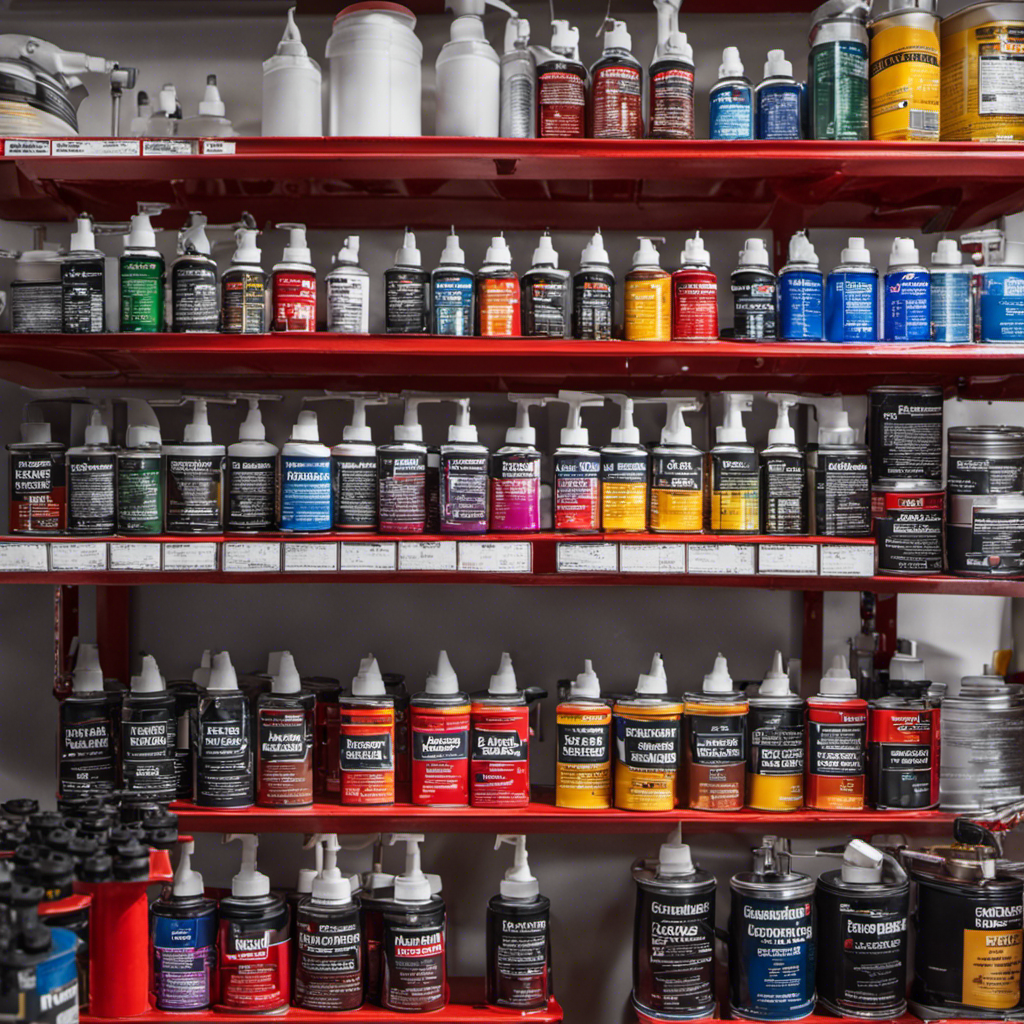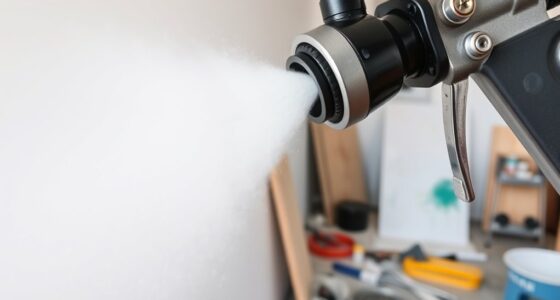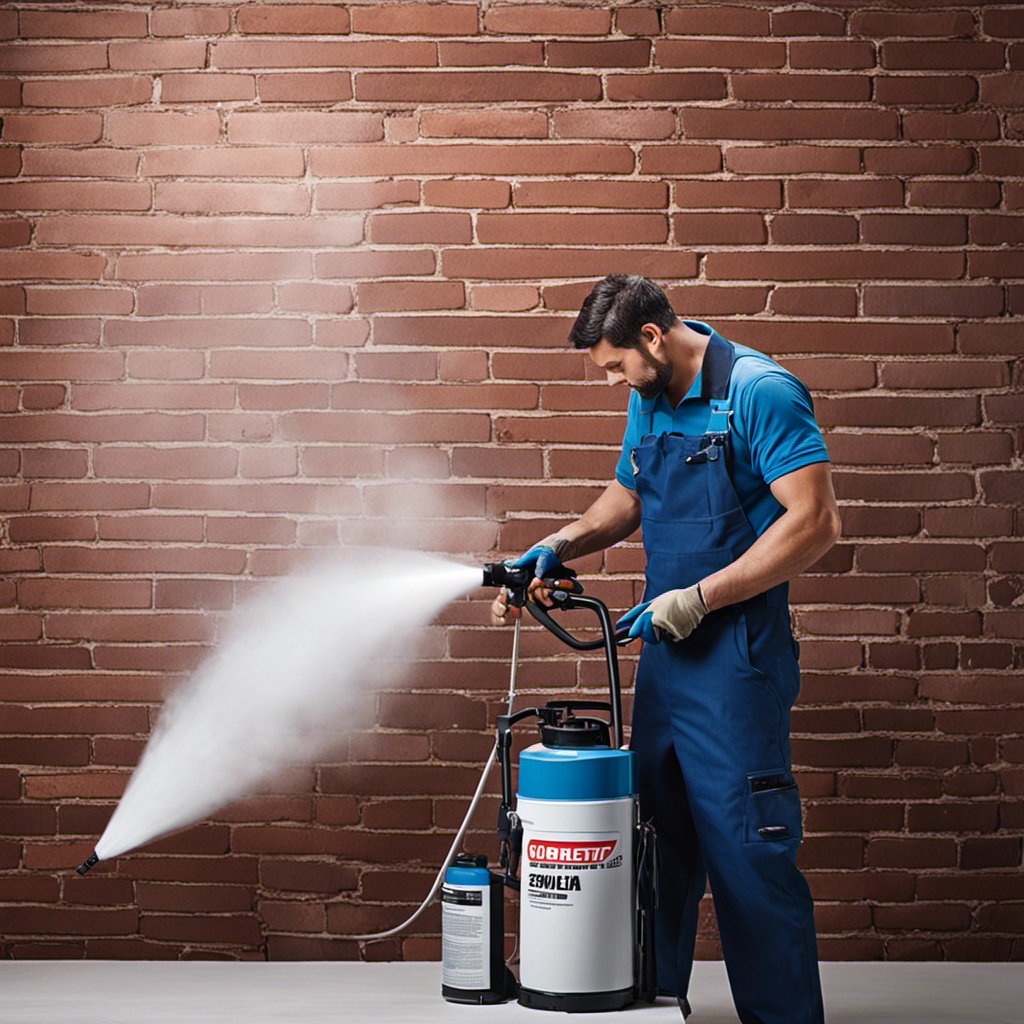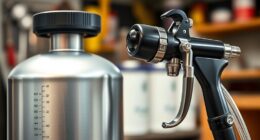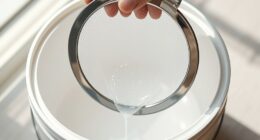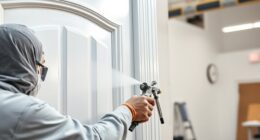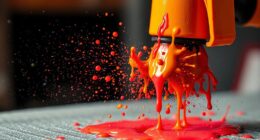It is crucial to perform regular maintenance on your airless paint sprayer in order to maintain its longevity and efficiency. Failing to do so can result in clogs and malfunctions, decreasing the sprayer’s performance and possibly requiring expensive repairs.
By flushing out paint, removing filters, tips, and guards, and preventing paint buildup in small crevices, users can keep their sprayer operating smoothly.
This detailed and informative article explores the importance of proper cleaning techniques and offers valuable tips for maintaining the longevity and efficient performance of an airless paint sprayer.
Key Takeaways
- Regular cleaning and maintenance of your airless paint sprayer is crucial for maintaining its performance and preventing clogs or malfunctions.
- Using water-based cleaning solutions such as diluted dish soap, vinegar and water mixture, and warm water with mild detergent can effectively remove paint buildup from the system.
- Proper cleaning techniques include flushing the system, cleaning the spray gun, hose, pump, and pressure roller separately to ensure thorough cleaning.
- Rinsing the roller with clean water, inspecting for leftover paint or debris, and allowing it to air dry completely before storing are important steps for effective airless sprayer maintenance.
The Performance Benefits of Regular Cleaning
Regular cleaning of an airless paint sprayer is essential for optimal performance. It prevents clogs or malfunctions and ensures efficient paint application. The benefits of regular maintenance are numerous, including extending the equipment’s lifespan and saving money on repairs. To effectively clean the sprayer, it is crucial to flush out any paint from the system. Additionally, removing filters, tips, and guards separately is important for a thorough cleaning. Paying attention to small crevices prevents paint buildup, which can lead to clogs and affect the sprayer’s performance. By incorporating these effective cleaning techniques into a regular maintenance routine, users can achieve consistent and high-quality paint application.
Extending the Lifespan of Your Airless Paint Sprayer
To extend the lifespan of an airless paint sprayer, users should consult the manufacturer’s instructions for proper maintenance guidelines. Regular cleaning and maintenance are crucial for the longevity and efficiency of the equipment. Cleaning frequency recommendations vary depending on usage, but generally, it is recommended to clean the sprayer after each use and establish a maintenance schedule. This helps prevent clogs, malfunctions, and saves money on repairs. By following the manufacturer’s guidelines, users can ensure that the sprayer is properly flushed and all components are cleaned thoroughly. Additionally, troubleshooting common issues such as clogged nozzles or uneven spray patterns can help maintain the sprayer’s performance. By lubricating moving parts and storing the sprayer in a clean and dry area, users can further extend the lifespan of their airless paint sprayer.
| Cleaning Techniques | Water-Based Cleaning Solutions | Rinsing Techniques for Effective Airless Sprayer Maintenance |
|---|---|---|
| Flushing the system | Diluted dish soap solution | Use clean water to rinse the roller |
| Cleaning the spray gun | Vinegar and water mixture | Thoroughly rinse every part of the roller |
| Cleaning the hose and pump | Warm water and mild detergent | Inspect for leftover paint or debris |
| Cleaning the pressure roller | Allow the roller to air dry completely | |
Flushing Out Paint: A Crucial Step in Maintenance
Flushing out paint from the airless paint sprayer is a crucial step in maintaining its performance and preventing clogs or malfunctions. Regular maintenance is of utmost importance to ensure the longevity and efficiency of the equipment.
Without proper cleaning, paint residue can accumulate and cause blockages in the system, leading to reduced spray quality or even complete failure. To prevent clogs and malfunctions, it is necessary to remove filters, tips, and guards separately and pay attention to small crevices where paint buildup may occur.
Using water-based cleaning solutions such as diluted dish soap, vinegar and water mixture, or warm water with mild detergent can effectively dissolve and remove paint residue. Flushing the system by removing Pump Armor, cleaning the spray gun, hose, pump, and pressure roller, and properly rinsing all parts are essential steps in airless sprayer maintenance.
The Importance of Cleaning Filters, Tips, and Guards
Removing filters, tips, and guards separately ensures proper maintenance of the airless paint sprayer. Regular filter maintenance is crucial for the longevity and efficiency of the sprayer. Here are some tips for effective guard cleaning:
-
Remove and clean filters regularly: Filters prevent debris and contaminants from entering the sprayer system. Cleaning them regularly ensures optimal performance and prevents clogs.
-
Clean tips thoroughly: Tips can easily get clogged with dried paint or debris. Use a specialized cleaner and brush to remove any buildup and ensure a smooth, even spray pattern.
-
Pay attention to guard crevices: Guards can accumulate paint residue in small crevices, leading to uneven spray patterns. Use a brush or toothbrush to clean these areas thoroughly, removing any buildup.
Preventing Paint Buildup in Small Crevices
Regularly paying attention to small crevices prevents the buildup of paint in those areas of the airless paint sprayer. Preventing paint buildup in hard to reach areas is crucial for maintaining the optimal performance of the sprayer.
Neglecting these areas can lead to clogs and malfunctions, resulting in a decrease in efficiency and a need for expensive repairs. Regular maintenance is of utmost importance to ensure the longevity and efficiency of the equipment.
By regularly inspecting and cleaning the small crevices, such as the nozzle, filters, and other components, you can prevent paint from accumulating and causing blockages. This will ensure a smooth and uninterrupted flow of paint, resulting in a consistent and even spray pattern.
Therefore, including these small crevices in your regular maintenance routine is vital for the optimal performance of your airless paint sprayer.
Gentle and Effective Cleaning Solutions for Water-Based Paints
Using a diluted dish soap solution is a gentle and effective method for cleaning water-based paints from the airless paint sprayer. This alternative cleaning method offers several benefits over harsher chemicals. It is less harmful to the environment and safer to handle. Here are three reasons why gentle cleaning agents like dish soap are a great choice:
-
Effectiveness: Diluted dish soap breaks down the paint particles without damaging the inner components of the sprayer. It easily removes paint residue from the nozzle, hose, and pump, ensuring optimal performance.
-
Safety: Unlike strong solvents, dish soap is non-toxic and less likely to cause skin irritation or respiratory issues. This makes it a safer option for those who are sensitive to harsh chemicals.
-
Cost-efficiency: Dish soap is readily available and inexpensive compared to specialized cleaning agents. By using this alternative cleaning method, you can save money without compromising on the quality of the cleaning process.
When choosing a cleaning solution for water-based paints, consider the benefits of gentle cleaning agents like diluted dish soap as an effective and affordable option.
Using Vinegar and Water to Dissolve Paint Buildup
Vinegar and water mixture dissolves paint buildup effectively, making it an excellent choice for cleaning the airless paint sprayer. The acidity of vinegar helps break down the paint particles, allowing for easy removal and preventing clogs in the sprayer system.
When it comes to cleaning agent options, vinegar is a versatile and affordable alternative. To use vinegar for cleaning your airless paint sprayer, mix equal parts vinegar and water in a container. Then, disassemble the sprayer and soak the parts in the vinegar mixture for about 30 minutes. After soaking, scrub the parts with a brush to remove any remaining paint residue. Rinse the parts thoroughly with clean water and allow them to air dry before reassembling the sprayer.
Using vinegar and water as a cleaning method not only removes paint buildup effectively but also eliminates the need for harsh chemicals. By opting for this alternative cleaning method, you can ensure the longevity and efficiency of your airless paint sprayer while being environmentally conscious.
Removing Paint Residue With Warm Water and Mild Detergent
To effectively remove paint residue from the airless paint sprayer, one can utilize warm water and a mild detergent solution. This method not only helps in preventing residue buildup but also promotes the use of eco-friendly cleaners.
Here are three reasons why this technique is beneficial:
-
Gentle and Effective Cleaning: Warm water combined with a mild detergent is a gentle yet effective solution for removing paint residue from the sprayer. It helps break down the paint particles without causing any damage to the equipment.
-
Eco-Friendly Approach: By using a mild detergent solution, you are opting for an eco-friendly cleaning method. This reduces the use of harsh chemicals that can harm the environment.
-
Thorough Removal of Residue: The combination of warm water and mild detergent ensures that all paint residue is completely removed from the sprayer. This helps maintain the efficiency and performance of the equipment, preventing any clogs or malfunctions.
Flushing the System: A Step-by-Step Cleaning Technique
Flushing the system thoroughly removes paint residue and prevents clogs or malfunctions in the airless paint sprayer.
To begin, remove any remaining paint or cleaning solution from the sprayer by rinsing it with clean water.
Next, prepare a cleaning agent by using diluted dish soap, vinegar and water mixture, or warm water with mild detergent.
Fill the container of the sprayer with the cleaning agent and attach it to the sprayer.
Start spraying until the liquid coming out is clear, indicating that the system is free from any paint residue.
It is important to pay attention to small crevices and remove any filters, tips, or guards separately for a thorough cleaning.
Flushing the system regularly, using different cleaning agent alternatives, is essential for maintaining the longevity and efficiency of the airless paint sprayer.
Additionally, troubleshooting common issues like clogged nozzles or uneven spray patterns can be prevented with proper cleaning and maintenance.
Cleaning the Spray Gun: Tips and Tools
Using a specialized cleaner and brush, the user can effectively clean the spray gun of an airless paint sprayer. Cleaning the spray gun is a crucial step in maintaining the longevity and efficiency of the equipment.
Here are some important tips and tools to consider:
-
Common Mistakes to Avoid:
- Neglecting to clean the spray gun after each use can lead to paint buildup and clogs.
- Using harsh chemicals or abrasive materials can damage the gun’s components.
- Failing to disassemble the gun properly can result in incomplete cleaning.
-
Recommended Cleaning Frequency:
- It is recommended to clean the spray gun after every painting session.
- Regular cleaning prevents paint residue from drying and clogging the gun.
- Cleaning the gun thoroughly ensures consistent and high-quality spray patterns.
Flushing and Cleaning the Hose and Pump
The user can effectively maintain their airless paint sprayer by regularly flushing and cleaning the hose and pump. Proper cleaning techniques are crucial to prevent common issues with clogged nozzles and ensure the longevity and efficiency of the equipment.
To clean the hose and pump, the user should start by removing any remaining paint from the system by flushing it with a cleaning solution. This can be done by removing the Pump Armor and filling the container with the cleaning agent, then spraying it until the solution comes out clear.
Additionally, the spray gun should be cleaned using a specialized cleaner and brush.
Soaking, Scrubbing, and Rinsing the Pressure Roller
To effectively clean the pressure roller of an airless paint sprayer, the user should soak it, scrub it, and then rinse it thoroughly. Here are three essential techniques for maintaining the pressure roller:
-
Soaking Techniques:
Begin by removing the roller from the sprayer. Fill a bucket or container with warm water and add a mild detergent or specialized paint roller cleaner. Submerge the roller completely and let it soak for 10-15 minutes. This will loosen any dried paint or residue, making it easier to clean. -
Scrubbing:
After soaking, use a soft-bristle brush or sponge to scrub the roller thoroughly. Pay attention to all areas, including the core and fabric. Scrub in gentle circular motions to ensure all paint particles are removed. -
Rinsing:
Once scrubbed, rinse the roller under clean water to remove any remaining paint or cleaning solution. Inspect the roller for any leftover debris or paint, and repeat the rinsing process if necessary. Finally, allow the roller to air dry completely before storing.
Rinsing Techniques for Effective Airless Sprayer Maintenance
After thoroughly scrubbing the pressure roller, the user should rinse it under clean water to remove any remaining paint or cleaning solution. This step is crucial to ensure the roller is completely clean and ready for the next use. Rinsing the roller properly is essential for effective airless sprayer maintenance.
Here are some tips for effectively rinsing the pressure roller of an airless paint sprayer:
-
Use clean water: Fill a bucket or sink with clean water to rinse the roller thoroughly.
-
Rinse every part: Make sure to rinse every part of the roller, including the core and fabric, to remove any leftover paint or cleaning solution.
-
Inspect and repeat: After rinsing, inspect the roller for any leftover paint or debris. If necessary, repeat the rinsing process until the roller is completely clean.
-
Air dry: Once the roller is clean, allow it to air dry completely before storing to prevent any moisture buildup.
Properly cleaning the spray gun and hose of an airless paint sprayer is also important for maintaining its longevity and efficiency. Refer to the manufacturer’s instructions for specific cleaning guidelines and follow these steps regularly.
Maintenance Tips for Longevity and Efficient Performance
Regularly consulting the manufacturer’s instructions and establishing a maintenance schedule are crucial for maintaining the longevity and efficient performance of an airless paint sprayer. Here are the benefits of regular maintenance for airless paint sprayers:
-
Improved Performance: Regular maintenance ensures that the sprayer operates at its optimal level, delivering consistent and even paint coverage.
-
Cost Savings: By preventing major breakdowns or malfunctions, regular maintenance saves money on expensive repairs or the need to replace the entire sprayer.
-
Extended Lifespan: Taking care of the sprayer through regular maintenance helps to prolong its lifespan, allowing it to be used for many projects to come.
In addition to regular maintenance, it’s also important to troubleshoot common issues with airless paint sprayers. Some tips include checking for clogged nozzles, adjusting the spray pattern, and ensuring proper paint viscosity.
Frequently Asked Questions
Can I Use Any Cleaning Solution to Clean My Airless Paint Sprayer?
Using the wrong cleaning solution for your airless paint sprayer can potentially cause damage. It is important to choose the appropriate cleaning solution alternatives to ensure proper maintenance.
Using a diluted dish soap solution or a vinegar and water mixture can effectively dissolve paint buildup without harming the sprayer. Warm water and a mild detergent can be used to remove any remaining paint residue.
These gentle cleaning solutions will help maintain the longevity and efficiency of your airless paint sprayer.
How Often Should I Clean My Airless Paint Sprayer?
Regular maintenance is essential for the longevity and efficiency of an airless paint sprayer. To clean the sprayer properly, it’s important to follow the manufacturer’s instructions. Cleaning should be done after each use, and a maintenance schedule should be established.
This ensures that the sprayer performs optimally and prevents issues like clogged nozzles or uneven spray patterns. Lubricating moving parts and storing the sprayer in a clean and dry area also contribute to its longevity.
What Should I Do if I Notice a Clogged Nozzle or Uneven Spray Pattern?
If a user notices a clogged nozzle or uneven spray pattern, they can troubleshoot the issue by following some maintenance techniques.
First, they should check for any obstructions in the nozzle and clean it thoroughly.
They can also adjust the spray pressure and inspect the paint filter for any clogs.
Additionally, they should ensure that the paint viscosity is appropriate for the sprayer.
Is It Necessary to Lubricate the Moving Parts of My Paint Sprayer?
Lubricating the moving parts of a paint sprayer is necessary for optimal performance and longevity. It reduces friction and wear, ensuring smooth operation. Additionally, proper lubrication prevents rust and corrosion, further protecting the equipment.
While regular cleaning is essential, lubrication benefits cannot be overlooked. It is recommended to consult the manufacturer’s instructions for specific lubrication guidelines. However, it is important to note that lubrication should not substitute thorough cleaning, as it can lead to paint buildup and clogs.
Can I Store My Airless Paint Sprayer in a Damp Area?
Storing an airless paint sprayer in a damp area is not recommended. Moisture can cause damage to the internal components of the sprayer, leading to malfunctions and reduced efficiency.
It is essential to store the sprayer in a clean and dry area to ensure longevity and proper functioning.
Additionally, using the proper cleaning solutions for the sprayer, such as diluted dish soap or vinegar and water mixture, will help remove paint buildup and maintain the sprayer’s efficiency.
Conclusion
In conclusion, maintaining proper cleanliness and upkeep of an airless paint sprayer is of utmost importance for its long-lasting functionality and optimal performance. Regular cleaning prevents any potential clogs or malfunctions, ensuring efficiency and saving costs on repairs.
By diligently flushing out paint, removing filters, tips, and guards, and paying attention to small crevices, one can prevent paint buildup and extend the lifespan of the equipment. Thoroughly cleaning the spray gun, hose, pump, and pressure roller using water-based solutions guarantees effective maintenance.
Following manufacturer’s instructions, establishing a maintenance schedule, troubleshooting common issues, and practicing proper storage techniques further enhance the longevity and efficiency of the airless paint sprayer.
Franz came aboard the Paint Sprayer Zone team with a background in both journalism and home renovation. His articulate writing style, combined with a passion for DIY projects, makes him an invaluable asset. Franz has a knack for breaking down technical jargon into easy-to-understand content, ensuring that even the most novice of readers can grasp the complexities of paint sprayers.
